Page 4207 of 4323
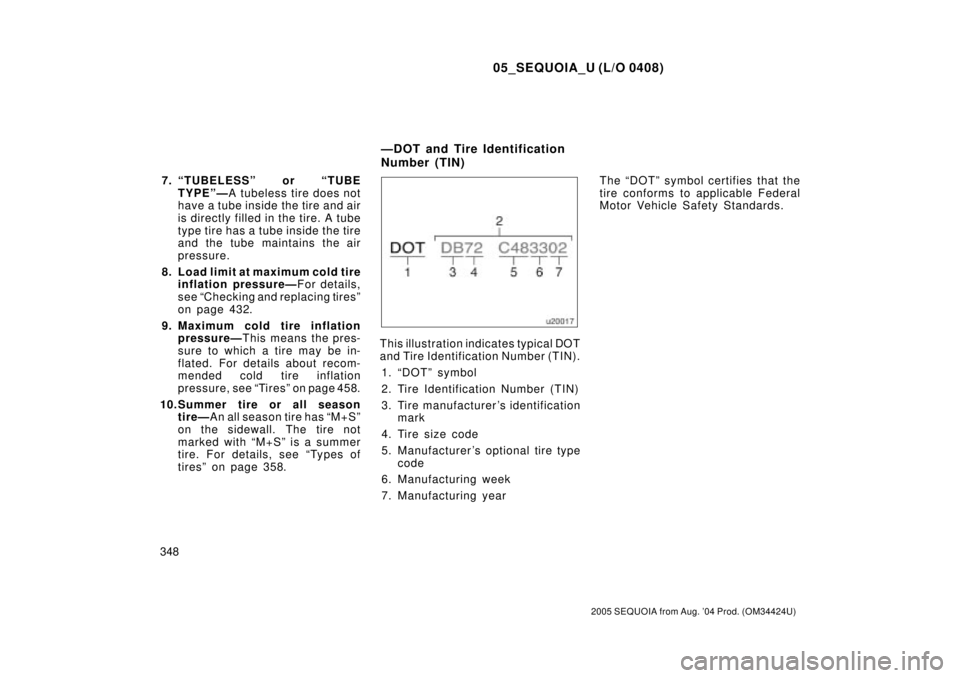
05_SEQUOIA_U (L/O 0408)
348
2005 SEQUOIA from Aug. '04 Prod. (OM34424U)
7. ªTUBELESSº or ªTUBE
TYPEºÐA tubeless tire does not
have a tube inside the tire and air
is directly filled in the tire. A tube
type tire has a tube inside the tire
and the tube maintains the air
pressure.
8. Load limit at maximum cold tire
inflation pressureÐFor details,
see ªChecking and replacing tiresº
on page 432.
9. Maximum cold tire inflation
pressureÐThis means the pres-
sure to which a tire may be in-
flated. For details about recom-
mended cold tire inflation
pressure, see ªTiresº on page 458.
10.Summer tire or all season
tireÐAn all season tire has ªM+Sº
on the sidewall. The tire not
marked with ªM+Sº is a summer
tire. For details, see ªTypes of
tiresº on page 358.
This illustration indicates typical DOT
and Tire Identification Number (TIN).
1. ªDOTº symbol
2. Tire Identification Number (TIN)
3. Tire manufacturer 's identification
mark
4. Tire size code
5. Manufacturer 's optional tire type
code
6. Manufacturing week
7. Manufacturing yearThe ªDOTº symbol certifies that the
tire conforms to applicable Federal
Motor Vehicle Safety Standards.
ÐDOT and Tire Identification
Number (TIN)
Page 4208 of 4323
05_SEQUOIA_U (L/O 0408)
349
2005 SEQUOIA from Aug. '04 Prod. (OM34424U)
This illustration indicates typical tire
size.
1. Tire use (P=Passenger car,
T=Temporary use)
2. Section width (in millimeters)
3. Aspect ratio (tire height to section
width)
4. Tire construction code (R=Radial,
D=Diagonal)
5. Wheel diameter (in inches)
6. Load index (2 digits or 3 digits)
7. Speed symbol (alphabet with one
letter)1. Section width
2. Tire height
3. Wheel diameter1. Bead
2. Sidewall
3. Shoulder
4. Tread
5. Belt
6. Inner liner
7. Reinforcing rubber
8. Carcass
9. Rim lines
10.Bead wires
11. Chafer
ÐTire size ÐName of each section of tire
Page 4212 of 4323

05_SEQUOIA_U (L/O 0408)
353
2005 SEQUOIA from Aug. '04 Prod. (OM34424U)
Ti r e relat ed ter mMeaning
Normal occupant weight68 kg (150 lb.) times the number of occupants specified in the second
column of Table 1 that follows
Occupant distributiondistribution of occupants in a vehicle as specified in the third column of Table
1 that follows
Production options weight
the combined weight of those installed regular production options weighing
over 2.3 kg (5 lb.) in excess of those standard items which they replace,
not previously considered in curb weight or accessory weight, including
heavy duty brakes, ride levelers, roof rack, heavy duty battery, and special
trim
Recommended inflation pressurecold tire inflation pressure recommended by a manufacturer
Rima metal support for a tire or a tire and tube assembly upon which the tire beads
are seated
Rim diameter (Wheel diameter)nominal diameter of the bead seat
Rim size designationrim diameter and width
Rim type designationthe industry of manufacturer 's designation for a rim by style or code
Rim widthnominal distance between rim flanges
Vehicle capacity weight
(Total load capacity)the rated cargo and luggage load plus 68 kg (150 lb.) times the vehicle's desig-
nated seating capacity
Vehicle maximum load on the tirethe load on an individual tire that is determined by distributing to each axle
its share of the maximum loaded vehicle weight and dividing by two
Page 4214 of 4323
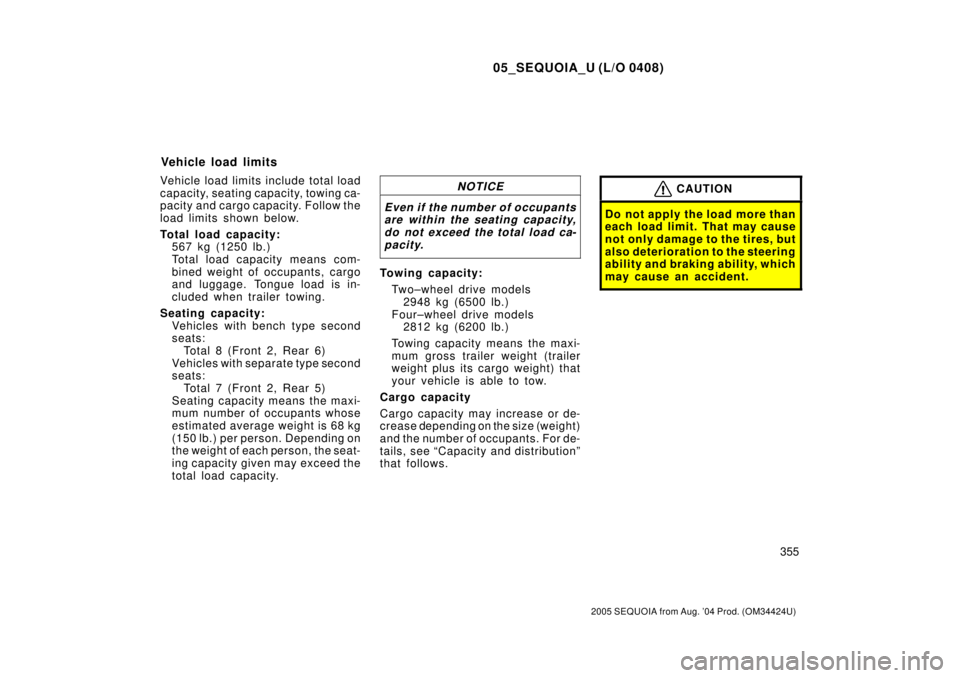
05_SEQUOIA_U (L/O 0408)
355
2005 SEQUOIA from Aug. '04 Prod. (OM34424U)
Vehicle load limits include total load
capacity, seating capacity, towing ca-
pacity and cargo capacity. Follow the
load limits shown below.
Total load capacity:
567 kg (1250 lb.)
Total load capacity means com-
bined weight of occupants, cargo
and luggage. Tongue load is in-
cluded when trailer towing.
Seating capacity:
Vehicles with bench type second
seats:
Total 8 (Front 2, Rear 6)
Vehicles with separate type second
seats:
Total 7 (Front 2, Rear 5)
Seating capacity means the maxi-
mum number of occupants whose
estimated average weight is 68 kg
(150 lb.) per person. Depending on
the weight of each person, the seat-
ing capacity given may exceed the
total load capacity.NOTICE
Even if the number of occupants
are within the seating capacity,
do not exceed the total load ca-
pacity.
Towing capacity:
Two±wheel drive models
2948 kg (6500 lb.)
Four±wheel drive models
2812 kg (6200 lb.)
Towing capacity means the maxi-
mum gross trailer weight (trailer
weight plus its cargo weight) that
your vehicle is able to tow.
Cargo capacity
Cargo capacity may increase or de-
crease depending on the size (weight)
and the number of occupants. For de-
tails, see ªCapacity and distributionº
that follows.
CAUTION
Do not apply the load more than
each load limit. That may cause
not only damage to the tires, but
also deterioration to the steering
ability and braking ability, which
may cause an accident.
Veh icle lo ad limit s
Page 4218 of 4323
05_SEQUOIA_U (L/O 0408)
359
2005 SEQUOIA from Aug. '04 Prod. (OM34424U)
All season tires, however, do not have
adequate traction performance
compared with snow tires in heavy or
loose snow. Also, all season tires fall
short in acceleration and handling
performance compared with summer
tires in highway driving.
The details about how to distinguish
summer tires from all season tires are
described on page 347.
CAUTION
�Do not mix summer and all sea-
son tires on your vehicle as
this can cause dangerous han-
dling characteristics, resulting
in loss of control.
�Do not use tire other than the
manufacturer's designated
tires, and never mix tires or
wheels of the sizes different
from the originals.
Page 4288 of 4323
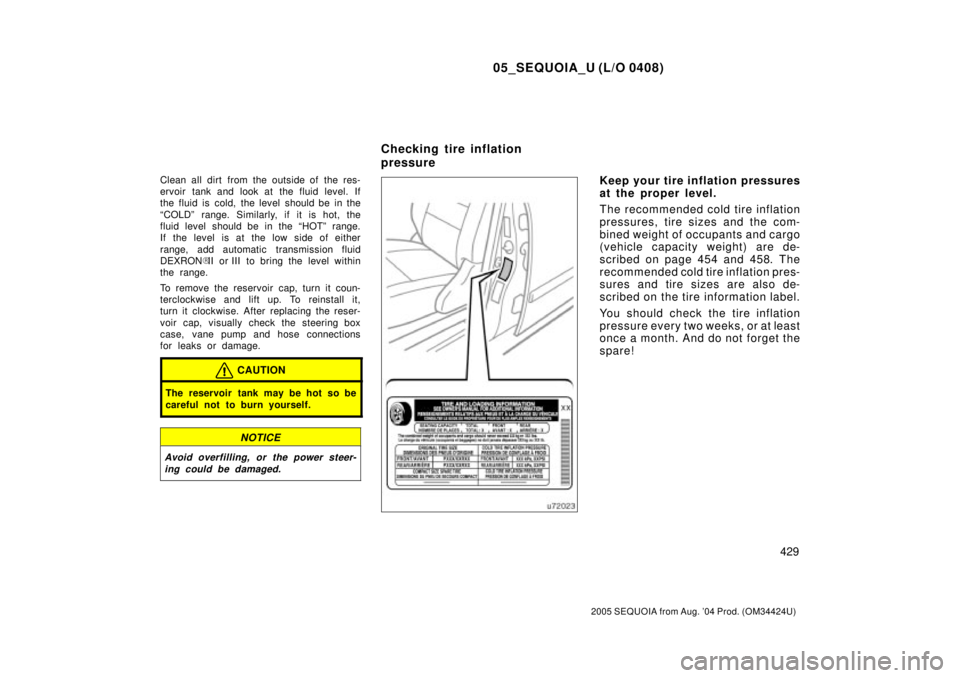
05_SEQUOIA_U (L/O 0408)
429
2005 SEQUOIA from Aug. '04 Prod. (OM34424U)
Clean all dirt from the outside of the res-
ervoir tank and look at the fluid level. If
the fluid is cold, the level should be in the
ªCOLDº range. Similarly, if it is hot, the
fluid level should be in the ªHOTº range.
If the level is at the low side of either
range, add automatic transmission fluid
DEXRON�II or III to bring the level within
the range.
To remove the reservoir cap, turn it coun-
terclockwise and lift up. To reinstall it,
turn it clockwise. After replacing the reser-
voir cap, visually check the steering box
case, vane pump and hose connections
for leaks or damage.
CAUTION
The reservoir tank may be hot so be
careful not to burn yourself.
NOTICE
Avoid overfilling, or the power steer-
ing could be damaged.
Keep your tire inflation pressures
at the proper level.
The recommended cold tire inflation
pressures, tire sizes and the com-
bined weight of occupants and cargo
(vehicle capacity weight) are de-
scribed on page 454 and 458. The
recommended cold tire inflation pres-
sures and tire sizes are also de-
scribed on the tire information label.
You should check the tire inflation
pressure every two weeks, or at least
once a month. And do not forget the
spare!
Checking tire inflation
pressure
Page 4291 of 4323
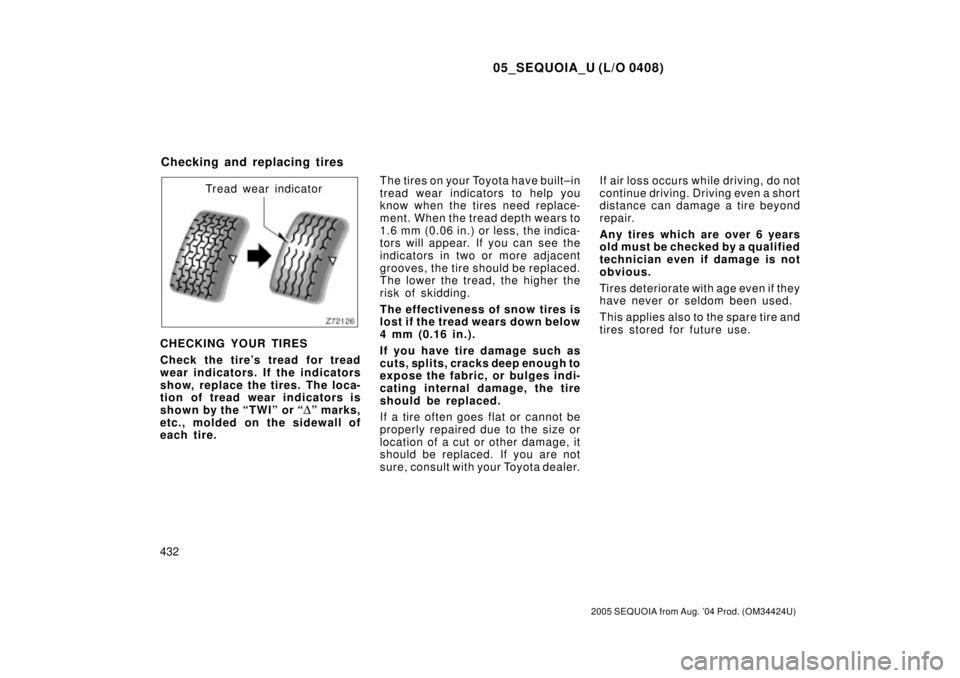
05_SEQUOIA_U (L/O 0408)
432
2005 SEQUOIA from Aug. '04 Prod. (OM34424U)
Tread wear indicator
CHECKING YOUR TIRES
Check the tire's tread for tread
wear indicators. If the indicators
show, replace the tires. The loca-
tion of tread wear indicators is
shown by the ªTWIº or ª
Dº marks,
etc., molded on the sidewall of
each tire.The tires on your Toyota have built±in
tread wear indicators to help you
know when the tires need replace-
ment. When the tread depth wears to
1.6 mm (0.06 in.) or less, the indica-
tors will appear. If you can see the
indicators in two or more adjacent
grooves, the tire should be replaced.
The lower the tread, the higher the
risk of skidding.
The effectiveness of snow tires is
lost if the tread wears down below
4 mm (0.16 in.).
If you have tire damage such as
cuts, splits, cracks deep enough to
expose the fabric, or bulges indi-
cating internal damage, the tire
should be replaced.
If a tire often goes flat or cannot be
properly repaired due to the size or
location of a cut or other damage, it
should be replaced. If you are not
sure, consult with your Toyota dealer.If air loss occurs while driving, do not
continue driving. Driving even a short
distance can damage a tire beyond
repair.
An y ti res wh i ch are over 6 years
old must be checked by a qualified
technician even if damage is not
obvious.
Tires deteriorate with age even if they
have never or seldom been used.
This applies also to the spare tire and
tires stored for future use.
Checking and replacing tires
Page 4292 of 4323
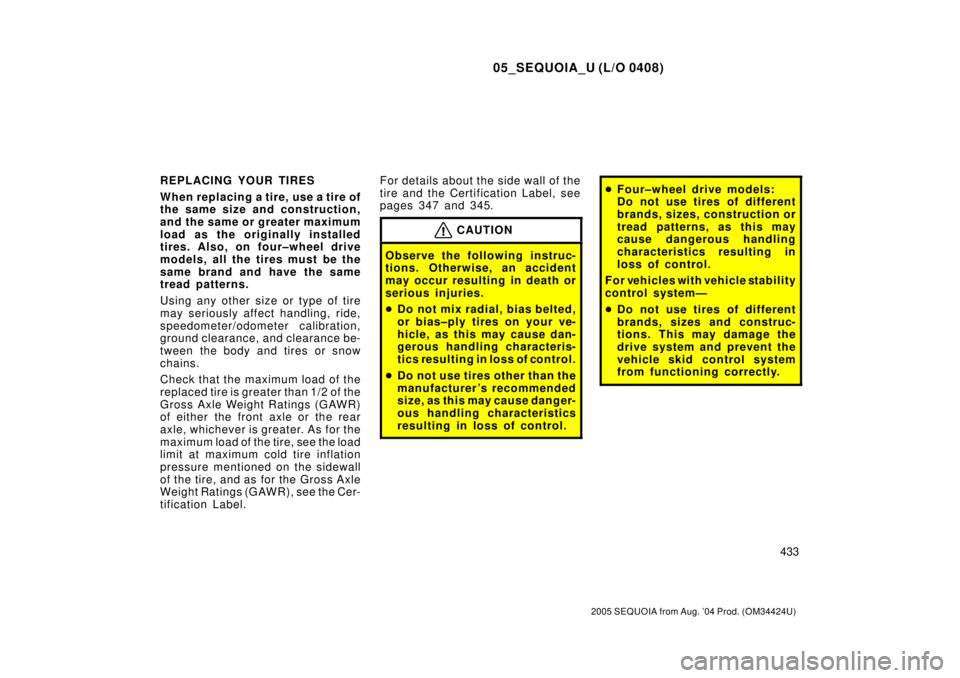
05_SEQUOIA_U (L/O 0408)
433
2005 SEQUOIA from Aug. '04 Prod. (OM34424U)
REPLACING YOUR TIRES
When replacing a tire, use a tire of
the same size and construction,
and the same or greater maximum
load as the originally installed
tires. Also, on four±wheel drive
models, all the tires must be the
same brand and have the same
tread patterns.
Using any other size or type of tire
may seriously affect handling, ride,
speedometer/odometer calibration,
ground clearance, and clearance be-
tween the body and tires or snow
chains.
Check that the maximum load of the
replaced tire is greater than 1/2 of the
Gross Axle Weight Ratings (GAWR)
of either the front axle or the rear
axle, whichever is greater. As for the
maximum load of the tire, see the load
limit at maximum cold tire inflation
pressure mentioned on the sidewall
of the tire, and as for the Gross Axle
Weight Ratings (GAWR), see the Cer-
tification Label.For details about the side wall of the
tire and the Certification Label, see
pages 347 and 345.
CAUTION
Observe the following instruc-
tions. Otherwise, an accident
may occur resulting in death or
serious injuries.
�Do not mix radial, bias belted,
or bias±ply tires on your ve-
hicle, as this may cause dan-
gerous handling characteris-
tics resulting in loss of control.
�Do not use tires other than the
manufacturer's recommended
size, as this may cause danger-
ous handling characteristics
resulting in loss of control.
�Four±wheel drive models:
Do not use tires of different
brands, sizes, construction or
tread patterns, as this may
cause dangerous handling
characteristics resulting in
loss of control.
For vehicles with vehicle stability
control systemÐ
�Do not use tires of different
brands, sizes and construc-
tions. This may damage the
drive system and prevent the
vehicle skid control system
from functioning correctly.